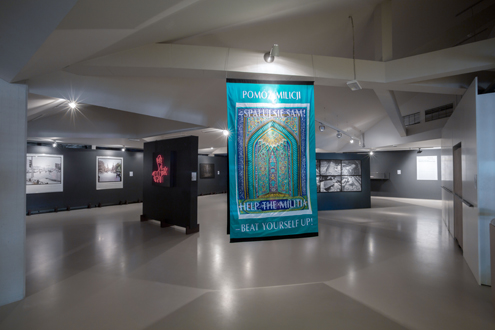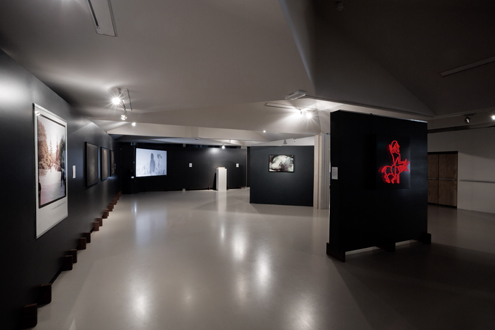Interview: Elham Puriya Mehr about the exhibition 'Crisis of History'
Curator Elham Puriamehr about the exhibition Crisis of History#3 – Beyond History
Since 2010 curator Robert Kluijver has been the initiator of the exhibition-triptych Crisis of History, supported by Framer Framed. The outcome is an impressive curatorial deconstruction of Western perceptions of the Middle East. For Beyond History, the final and most challenging part the tryptich, Kluijver invited the Iranian curator Elham Puriyamehr to join forces. She explains the chosen approach.
Can you describe what makes Beyond History extraordinary?
We live in an era marked by a multiplicity of narratives, whose only common feature is the fact of being discursive. Although these narratives proliferate and metamorphose, they remain within the framework of the historical meta-narrative. “Beyond History” has a different outlook on the uncertainty of contemporary life. It challenges the modern description of the “Middle East”, exposing this prevailing description as a factor isolating the Middle East from the ‘real world’. In fact, the exhibition aims to venture beyond all the definitions and historical narratives we have known to this moment.
Can you give some examples of the methods artists use to ‘undermine the ideological edifice of history’?
It is clear that all of us live within the framework of the historical meta-narrative theoretically and practically. Nevertheless, we are not well aware of its existence and live in the state of uncertainty. I think the best curatorial method is to use the discourse of uncertainty and place the audience in the same situation. It is this position specifically that artists, too, sincerely aim to explore in their work. In the end it is not necessarily the artists individually, however, who transport us ‘beyond the history’ – it is the exhibition as a whole which attempts to achieve this, by bringing together and juxtaposing a variety of artists.
Which criteria were especially important for the choice of the artists/works for Beyond History?
I tried to select the artworks for the exhibition based on the subject, space and audiences. It was also important for Robert and me to gather personal narratives of artists from social, cultural, political and historical points of view. By collecting different narratives we tried to deconstruct the historical Meta narrative.
What do you hope to achieve with Beyond History?
For Robert and me, providing a good platform for thinking and discussing is very important. Exhibition and lectures with contemporary approach about art of the Middle East will break the boundaries and prepare the possibility of real dialogue between the various narratives, entering new space that we have named Beyond History.
Highlights of Crisis of History #3: Beyond History
SLAVS AND TATARS – Friendship of Nations: Polish Shi’ite Showbiz
Slavs and Tatars is a faction of polemics and intimacies devoted to an area east of the former Berlin Wall and west of the Great Wall of China known as Eurasia. The collective is founded in 2006. Through installations, books and lecture-perfomances Slavs and Tatars focuses on an oft-forgotten sphere of influence between Slavs, Caucasians and Central Asians. Beyond History presents richly embroidered and decorated, transnational banners and flags belonging to the Slavs and Tatars’ project ‘Friendship of Nations: Polish Shi’ite Showbiz’.
The fact that it is not exactly clear who are the members did not hamper a fast growing impact of Slavs and Tatars in international media and the artistic discourse, resulting in recent exhibits at MoMA New York, Kunsthalle Zurich, Vienna Seccession, Tate Modern and the 9th Gwangju Biennial. Slavs and Tatars is nominated for the prestigious German Preis der Nationalgalerie 2015.
http://www.slavsandtatars.com/
Barbad Golshiri
Barbad Golshire was born in 1982, Tehran. As an artist, critic, curator and tombstone maker, the medium he works with varies from video, installation, photography, documented performance to critical writing. Also, he is a translator and editor of Samuel Beckett’s dramatic works into Persian. Most of his works are language-based and contend with art and literature’s plane of the feasible. His major approach towards plastic and visual arts has been described by himself as ‘Aplasticism’; a plasticism that tends toward sightlessness, a visual art that negates visual perception yet still remains a plasticism. Golshiri has also been portrayed as a critic of the current socio-political situation in Iran, hegemony of the new art market of the region and the living doxas. During the past years he has been creating mostly grave markers.
http://www.barbadgolshiri.com/
BABAK GOLKAR – Throw(n)
Babak Golkar (1977) grew up in Tehran and immigrated to Vancouver at 19. Educated as a ceramist and a post conceptual artist, he graduated in Fine Arts from Emily Carr Institute and Columbia University in Vancouver and is a rising star in the international art circuit. Golkar’s work investigates discrete human-made systems and the often unconscious frameworks of social codes and behaviors that are now accepted as constative.
For ‘The Return Project’ the artist sent back modified purchased items to the retail stores for his money back. This work was documented through a series of before and after photographs and collaged sculptures made from the residues of the original objects. For his recent solo-exhibition ‘Dialectic of failure’ he presented a series of abject-looking terracotta scream pots, available for the visitors of the West Vancouver Museum to scream into. ‘Beyond History’ features Golkar’s video installation titled ‘Throw(n)’ in which blobs of potter’s clay are artfully thrown against a clean white wall. Ample clay is available for the spectators to participate in throwing blobs on the wall where the video is projected.
“As many Iranians from my generation, I grew up in the war time. I’m not a journalist wanting to show reality in a direct way, as an artist I have an obligation to examine subjects from a personal and subjective point and digest it and transform them into multi-layered works of art that public can enter at least one of the layers. In a globalized world, and I don’t use this term lightly, humans are dealing with very similar issues. Unifying frustrations have been built up in the past couple of decades like never before. I like to tap into the systems that are inventing and reinforcing conditions that are overpowering and undermining the basic human conditions.”
http://babakgolkar.ca/
Iran / Middle East /
Exhibitions

Exhibition: Crisis of History #3 - Beyond History
Curated by Robert Kluiver and Elham Puriyamehr
Network






